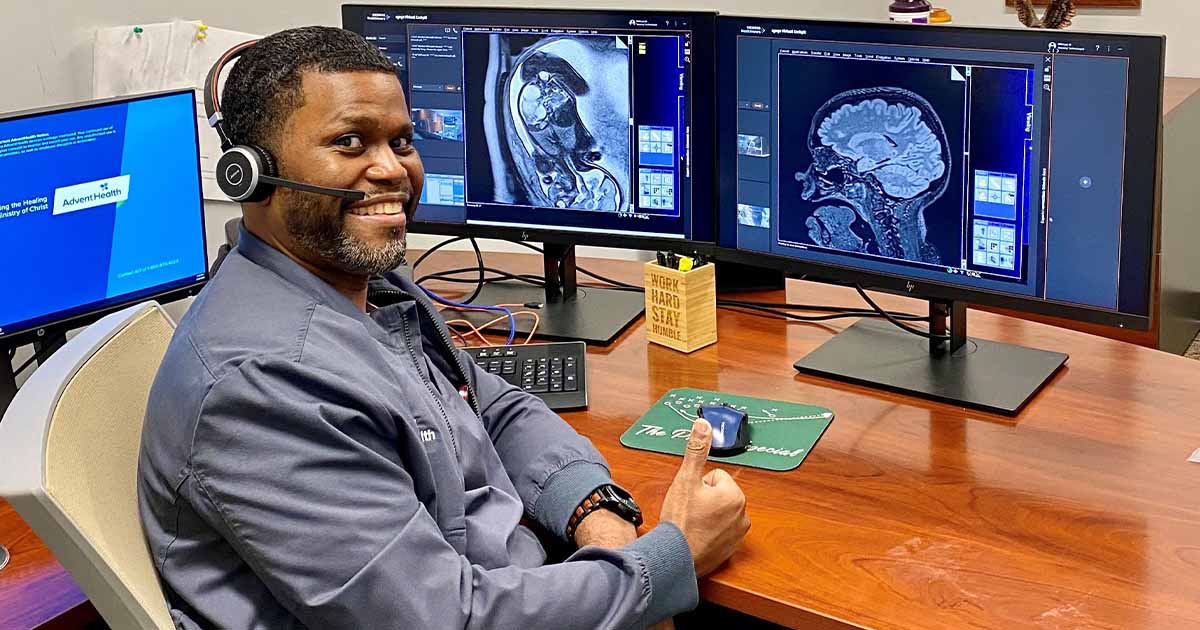
Not too long ago, AdventHealth had a high demand in its Central and East Florida divisions for advanced MRI services. The health system’s centralized MRI services at its Orlando campus, though effective, presented areas where AdventHealth could deliver a more consumer-centric experience.
THE PROBLEM
Expanding advanced MRI services to the community hospitals presented its own set of challenges. These locations did not have the same level of advanced training or standardized imaging protocols as the main campus. This opened the door to inconsistencies in processes that could lead to delays and affect the patient experience.
By reducing the need for patients to travel and wait for advanced imaging, staff knew they could make a significant impact. Staff also wanted to standardize protocols across community campuses to maintain consistently high imaging quality and reduce the need for repeat scans.
PROPOSAL
“To address these challenges, we proposed a virtual MRI program designed to decentralize our MRI services while maintaining high standards of care,” said Ike Ichite, vice president of imaging services at AdventHealth’s Central Florida Division. “This program used cutting-edge virtual care technology to facilitate real-time collaboration between experienced technologists and multiple scanning sites.
“The core idea was to provide remote guidance and support through live audio, chat and video functions, enabling technologists at community campuses to perform advanced MRI scans with the same proficiency as those at our main campus,” he explained.
The Virtual Operations Center was designed to streamline operations by eliminating the need for unnecessary patient transfers to the Orlando campus. This approach aimed to reduce inpatient hospital stays and outpatient wait times significantly.
By standardizing imaging protocols and providing continuous remote support, staff could ensure consistent high-quality imaging across all sites. This technology promised to enhance operational efficiency, improve patient satisfaction and reduce the frequency of repeat studies – ultimately leading to better patient outcomes and aligning with AdventHealth’s service standards of “Keep Me Safe,” “Love Me,” “Make It Easy” and “Own It,” Ichite said.
MEETING THE CHALLENGE
Implementation of the virtual MRI program began with three campuses, later expanding to 14 campuses as the program proved successful. Experienced technologists from the central campus provided remote support to up to three scanning sites simultaneously. This was facilitated through an advanced integration that included live audio, chat and video functions, ensuring real-time communication and support.
“The FDA-approved vendor software was initially integrated with Siemens MRI scanners but has been expanded to include other vendors, such as Philips,” Ichite noted. “The remote technologists can assist with protocol adjustments, troubleshooting, and ensuring the quality of the imaging studies. This setup allows us to maintain a high standard of imaging quality and consistency across all participating locations.
“The integration also included training programs for local frontline staff to familiarize them with new technology and protocols,” he continued. “This collaborative approach not only improved the quality of imaging studies but also enhanced the confidence and skills of the local frontline technologists and radiologists. The system was designed to seamlessly integrate with our existing workflows, ensuring minimal disruption and maximum efficiency.”
RESULTS
AdventHealth achieved a significant improvement in operational efficiency. The implementation of the virtual MRI program resulted in a 94% reduction in inpatient MRI transfers. This change alone reduced the length of hospital stays by at least 24 hours per patient, helping lower their cost of care and improve access to hospital beds for the community.
Additionally, cardiac MRI services experienced a 42% growth, which significantly improved access to specialized care for patients.
“The quality of our imaging studies improved remarkably,” Ichite reported. “Since the implementation, we have performed more than 3,000 advanced MRIs through the virtual platform. The rate of repeat studies dropped to zero, indicating a significant improvement in the initial quality of the imaging studies.
“Remote protocol adjustments were made 600 times, further ensuring the accuracy and quality of the scans,” he continued. “This reduction in repeat studies not only enhanced operational efficiency but also improved patient experience and satisfaction.”
The availability of outpatient advanced MRI studies with next-day scheduling across multiple sites has drastically reduced wait times for patients. This improvement in accessibility and convenience has had a positive impact on patient satisfaction.
“Patients no longer need to wait for weeks to get an appointment, and the decentralized approach has made advanced MRI services more readily available at locations that are closer to home for our patients,” Ichite noted.
ADVICE FOR OTHERS
For healthcare providers considering the adoption of similar virtual care technologies, Ichite offers the following advice based on AdventHealth’s experience:
-
Ensure virtual care technology is seamlessly integrated into existing systems and workflows. Resourcefulness and creativity are key.
-
Invest in comprehensive training programs for staff to familiarize them with the new technology and standardized protocols.
-
Start with a phased implementation, focusing initially on a few sites to gather data and demonstrate the improvements in operational efficiency, image quality and patient satisfaction.
-
Engage with all relevant stakeholders – including technologists, physicians, radiologists, information technology, providers and administrative staff – to build a strong support system for the implementation of the virtual care technology.
-
Always prioritize the patient experience. The ultimate goal of implementing virtual care technology should be to improve patient outcomes, reduce wait times and enhance the overall patient experience.
“By keeping the patient at the center of your efforts, you can ensure the technology truly adds value to the patients and the teams that care for them,” Ichite concluded.
Follow Bill’s HIT coverage on LinkedIn: Bill Siwicki
Email him: bsiwicki@himss.org
Healthcare IT News is a HIMSS Media publication.
